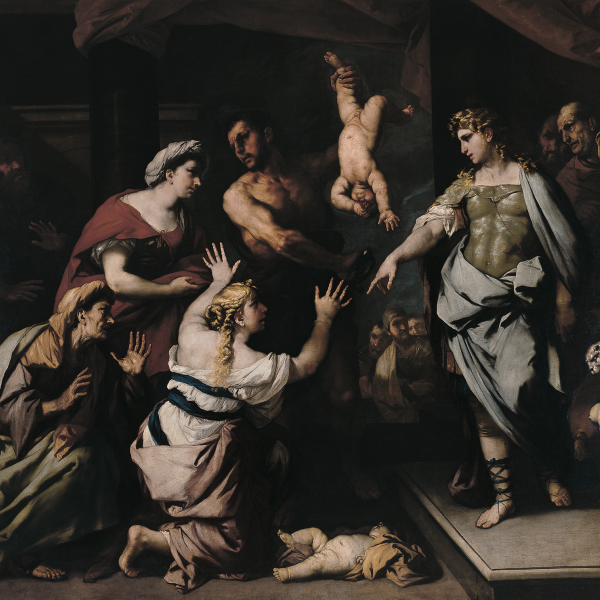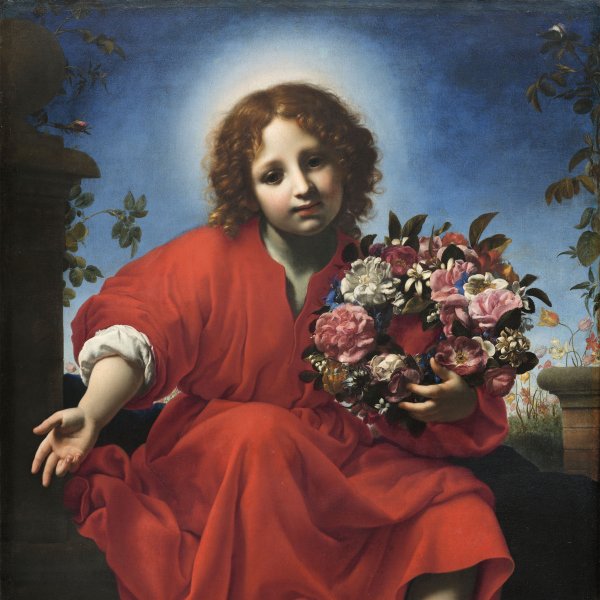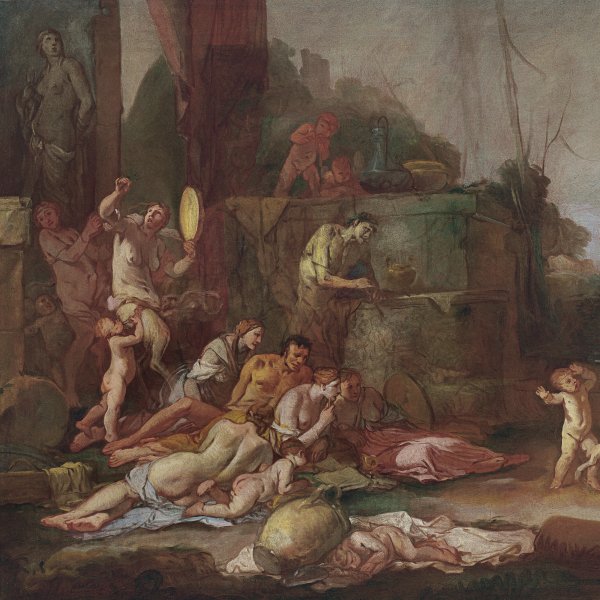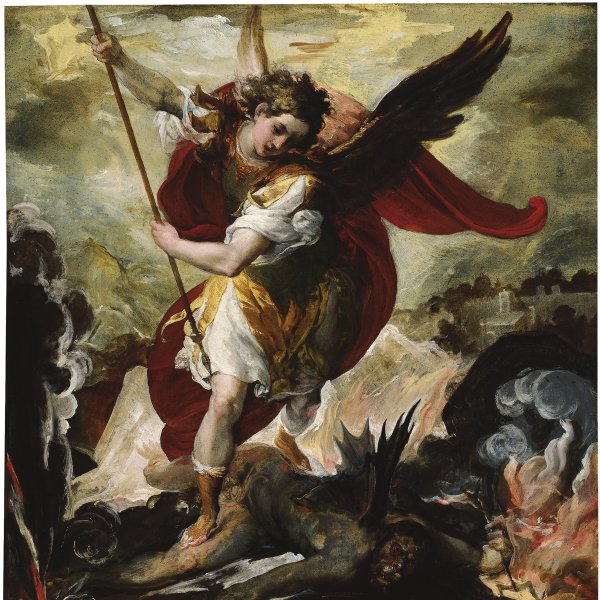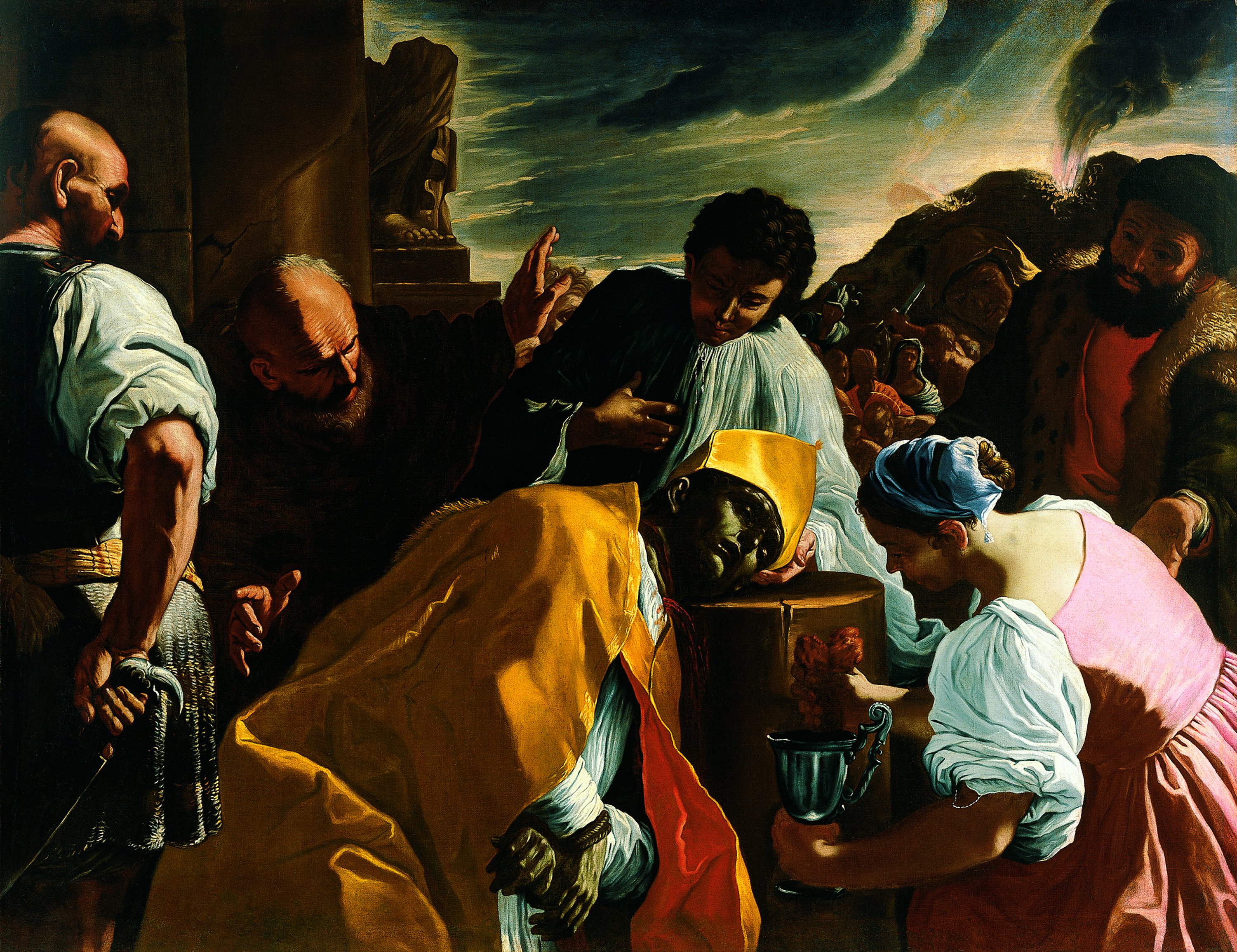The Martyrdom of Saint Januarius
ca. 1685
Oil on canvas.
153 x 200 cm
Carmen Thyssen Collection
Inv. no. (
CTB.1995.6
)
Room 14
Level 2
Permanent Collection
In generally good condition, the canvas appears to have been folded at the shorter sides. The losses are insignificant and are principally in the dress of the woman collecting the saint's blood, the lower edge of the cape, and some scattered areas in the lower part of the canvas. There are also tiny losses on St. Januarius's cape. The saint's face has the most extensive repainting which runs from his ear to the eye socket. Cleaning has heightened the contrasts in the chiaroscuro on the balding man, second from the left. Overall, the restoration, which has aimed to retain the glazes, has focused on the lighter tones thereby accentuating the impression of bright light. Under the varnish, some old over-painting is visible, for instance, in the sky to the right of the head of the deacon.
St. Januarius, bishop of Benevento, was martyred during the persecutions of Diocletian. After the attempt to have him eaten by lions in the amphitheatre of Puteoli (Pozzuoli) had failed, following the lions' refusal, the bishop in his golden vestments is here shown at the moment immediately after his head has been severed. The executioner has already sheathed his sword and his devout follower Eusebia is collecting Januarius's blood in a ewer. As is well known, this miraculous relic of the saint's blood is kept in the Cathedral of Naples and is greatly venerated for its supposed periodic liquefaction. Another version of the same composition is known, formerly in the collection of the Princes of Fondi in Naples and, later, until 1937, in that of the Princess Pignatelli della Leonessa. Judging from the dark reproduction of it in the Christie's, London catalogue, it seems to have been "caravaggesque" in its chiarscuro and, consequently, is earlier in date. Critical opinion regarding the present work has oscillated wildly. Matteo Marangoni (1921) thought it "tumultuous and fantastical", selecting it as "the most powerful and personal work" among those in the Cecconi Collection in Florence. Longhi (1922, see also 1961), however, consigned it to the status of a mediocre copy. This judgement was repeated more recently in less drastic tones, by Spear (1980: "The stiff, mechanical folds of the garments of this work, and the general lifelessness of the figural modelling impressed me as being quite typical of copies"). Spear also thought the above-mentioned Christie's version far better. Maurizio Marini (1989 and 1991) had a more position opinion, calling the former Cecconi painting-by then in a private collection in New York-"a good workshop copy" and identified the original work (oil on canvas, 155 x 215 cm) as a picture that he had "known when it was in a private collection in Rome." Unless there was a previous error in measurement, this latter work is not the same as the one at Christie's in 1980, given the evident disparity in format (the auction catalogue lists the measurements as 149.9 x 202 cm), but it is certainly identical to the one seen-and described as a copy-by Spike (in Princeton 1980) on the Rome art market in 1979 "reputedly with a Neapolitan provenance": that is to say the same provenance as the picture auctioned at Christie's the following year. These negative, or partially negative, judgements of the present painting, pronounced by Longhi, Spear and Marini, are partly compensated for by the high praise bestowed by Marangoni, Nugent (1930), and Spike who has correctly emphasised the need to judge the picture according to different parameters in light of its Maltese, rather than Neapolitan, origins and dating of the later 1680s.
Given the existence of several versions of the same, well-received, composition, one cannot say for sure that the Thyssen canvas is the same painting as the one described in De Dominici in the house of Giacomo di Marino, Marquis of Genzano, together with a pair, of greatly inferior quality, of stories of Joseph (Jacob sees Joseph's bloodstained Tunic, and Joseph interprets the Pharaoh's Dream): "Saint Januarius, already decapitated, whose body is at rest and whose head is on the stump on which the saint has stretched his neck to receive the blow of the executioner who has turned to the altar boy who holds the head of the Saint with his hand, and the Woman who, with her sponge collects the Blood, while the others are spectators of this martyrdom."
The progressive dilution of the still naturalistic structure into elements of a Giordano-esque Baroque type, lead one automatically to suggest for this canvas (in which even this writer cannot see the hand of the master throughout) a fairly late date of execution, perhaps, as mentioned above and in agreement with John Spike's opinion, well into the 1680s. It is true that the diagonal line created by the figure of St. Januarius is a compositional stratagem which the Calabrian painter was particular fond of, and one enjoyed using for many years. For example, the protagonist of the famous painting in the Royal Palace in Naples of The Prodigal Son, in which even the young accompanying figure on the right with a feather reminds one of the deacon who holds the head of St. Januarius here, even though his face is divided exactly between light and shade. In contrast, with a late painting such as The Beheading of Saint John the Baptist in San Domenico Maggiore in Naples one might deduce and ideal pair for the present work. Moreover, the saint in it is virtually symmetrical to St. Januarius: he has his hands tied like the other, but he has not yet been decapitated. In the centre of the background we see the same woman in a dark nun's habit with a hood who appears in the dark area on the right in the present picture. The Adoration of the Shepherds in Santa Maria Monteverginella in Naples also appears to be equally late, and also looks to Giordano in the insertion of the woman moving from the left to the centre with the basket of chickens on her head. In addition, the shepherd who is taking off his hat on the left is a younger but almost identical version of the armed man who fills the corresponding space in the Thyssen painting. Joseph, for his part, appears to be the same model used for the gesturing old man between the armed man and St. Januarius. However, as we have said, many of the constitutive elements of the still considerable Thyssen painting, a late copy of an earlier prototype still in part by the master's hand, can be traced back to works from several decades earlier. This is the case with the model used by Preti for the armed man on the left in Christ before Herod in the parish church of Sambughè near Treviso, who is very close to the one in the present painting.
Other typological foreshadowings (of the deacon, incomparably superior to the Thyssen-Bornemisza one), but also in structure (the figure in a pose similar to the one that will later characterise Saint Januarius) are evident in The Baptism of Constantine in Sant Agostino a Tortoreto, in the Abbruzzi, one of Preti's masterpieces of the 1660s. By this period, during the first part of his very lengthy stay in Malta, there already emerges that feminine type which reappears in The Beheading of Saint Januarius in the figure of his devout follower, Eusebia. Also worth recalling here is the fresco with The Sermon of Saint John the Baptist on the ceiling of the church of St. John in Valletta (1661-1666), and the accompanying figure on the right, half hidden by the sculpted bust, before which he is seated. Another example is the woman lying down on the left in the foreground with the sleeping child. In the same church is the lunette with The Birth of Mary, particularly the maid kneeling on the left with her back to the column. Especially close to the present figure of Eusebia is the woman with her hands raised and seen from behind on the right of the Rape of Dina, previously in a private collection in Rome, noted in De Dominici, who saw it in Naples in the collection of the Duke of Laviano. The bearded man with the fur collar in the shadow on the extreme right of the present work turns out to have been a household acquaintance of Preti's family. We can spot him again as Epulonius on the right in The Banquet of Epulonius (present whereabouts unknown); as the man with the turban behind Dido in Dido's Suicide in the Herzog Anton-Ulrich Museum in Brunswick (inv. no. 25), and as St. Luke in the Maltese canvas of Saint Luke Painting the Virgin, signed and dated 1671 (present whereabouts unknown).
Roberto Contini
St. Januarius, bishop of Benevento, was martyred during the persecutions of Diocletian. After the attempt to have him eaten by lions in the amphitheatre of Puteoli (Pozzuoli) had failed, following the lions' refusal, the bishop in his golden vestments is here shown at the moment immediately after his head has been severed. The executioner has already sheathed his sword and his devout follower Eusebia is collecting Januarius's blood in a ewer. As is well known, this miraculous relic of the saint's blood is kept in the Cathedral of Naples and is greatly venerated for its supposed periodic liquefaction. Another version of the same composition is known, formerly in the collection of the Princes of Fondi in Naples and, later, until 1937, in that of the Princess Pignatelli della Leonessa. Judging from the dark reproduction of it in the Christie's, London catalogue, it seems to have been "caravaggesque" in its chiarscuro and, consequently, is earlier in date. Critical opinion regarding the present work has oscillated wildly. Matteo Marangoni (1921) thought it "tumultuous and fantastical", selecting it as "the most powerful and personal work" among those in the Cecconi Collection in Florence. Longhi (1922, see also 1961), however, consigned it to the status of a mediocre copy. This judgement was repeated more recently in less drastic tones, by Spear (1980: "The stiff, mechanical folds of the garments of this work, and the general lifelessness of the figural modelling impressed me as being quite typical of copies"). Spear also thought the above-mentioned Christie's version far better. Maurizio Marini (1989 and 1991) had a more position opinion, calling the former Cecconi painting-by then in a private collection in New York-"a good workshop copy" and identified the original work (oil on canvas, 155 x 215 cm) as a picture that he had "known when it was in a private collection in Rome." Unless there was a previous error in measurement, this latter work is not the same as the one at Christie's in 1980, given the evident disparity in format (the auction catalogue lists the measurements as 149.9 x 202 cm), but it is certainly identical to the one seen-and described as a copy-by Spike (in Princeton 1980) on the Rome art market in 1979 "reputedly with a Neapolitan provenance": that is to say the same provenance as the picture auctioned at Christie's the following year. These negative, or partially negative, judgements of the present painting, pronounced by Longhi, Spear and Marini, are partly compensated for by the high praise bestowed by Marangoni, Nugent (1930), and Spike who has correctly emphasised the need to judge the picture according to different parameters in light of its Maltese, rather than Neapolitan, origins and dating of the later 1680s.
Given the existence of several versions of the same, well-received, composition, one cannot say for sure that the Thyssen canvas is the same painting as the one described in De Dominici in the house of Giacomo di Marino, Marquis of Genzano, together with a pair, of greatly inferior quality, of stories of Joseph (Jacob sees Joseph's bloodstained Tunic, and Joseph interprets the Pharaoh's Dream): "Saint Januarius, already decapitated, whose body is at rest and whose head is on the stump on which the saint has stretched his neck to receive the blow of the executioner who has turned to the altar boy who holds the head of the Saint with his hand, and the Woman who, with her sponge collects the Blood, while the others are spectators of this martyrdom."
The progressive dilution of the still naturalistic structure into elements of a Giordano-esque Baroque type, lead one automatically to suggest for this canvas (in which even this writer cannot see the hand of the master throughout) a fairly late date of execution, perhaps, as mentioned above and in agreement with John Spike's opinion, well into the 1680s. It is true that the diagonal line created by the figure of St. Januarius is a compositional stratagem which the Calabrian painter was particular fond of, and one enjoyed using for many years. For example, the protagonist of the famous painting in the Royal Palace in Naples of The Prodigal Son, in which even the young accompanying figure on the right with a feather reminds one of the deacon who holds the head of St. Januarius here, even though his face is divided exactly between light and shade. In contrast, with a late painting such as The Beheading of Saint John the Baptist in San Domenico Maggiore in Naples one might deduce and ideal pair for the present work. Moreover, the saint in it is virtually symmetrical to St. Januarius: he has his hands tied like the other, but he has not yet been decapitated. In the centre of the background we see the same woman in a dark nun's habit with a hood who appears in the dark area on the right in the present picture. The Adoration of the Shepherds in Santa Maria Monteverginella in Naples also appears to be equally late, and also looks to Giordano in the insertion of the woman moving from the left to the centre with the basket of chickens on her head. In addition, the shepherd who is taking off his hat on the left is a younger but almost identical version of the armed man who fills the corresponding space in the Thyssen painting. Joseph, for his part, appears to be the same model used for the gesturing old man between the armed man and St. Januarius. However, as we have said, many of the constitutive elements of the still considerable Thyssen painting, a late copy of an earlier prototype still in part by the master's hand, can be traced back to works from several decades earlier. This is the case with the model used by Preti for the armed man on the left in Christ before Herod in the parish church of Sambughè near Treviso, who is very close to the one in the present painting.
Other typological foreshadowings (of the deacon, incomparably superior to the Thyssen-Bornemisza one), but also in structure (the figure in a pose similar to the one that will later characterise Saint Januarius) are evident in The Baptism of Constantine in Sant Agostino a Tortoreto, in the Abbruzzi, one of Preti's masterpieces of the 1660s. By this period, during the first part of his very lengthy stay in Malta, there already emerges that feminine type which reappears in The Beheading of Saint Januarius in the figure of his devout follower, Eusebia. Also worth recalling here is the fresco with The Sermon of Saint John the Baptist on the ceiling of the church of St. John in Valletta (1661-1666), and the accompanying figure on the right, half hidden by the sculpted bust, before which he is seated. Another example is the woman lying down on the left in the foreground with the sleeping child. In the same church is the lunette with The Birth of Mary, particularly the maid kneeling on the left with her back to the column. Especially close to the present figure of Eusebia is the woman with her hands raised and seen from behind on the right of the Rape of Dina, previously in a private collection in Rome, noted in De Dominici, who saw it in Naples in the collection of the Duke of Laviano. The bearded man with the fur collar in the shadow on the extreme right of the present work turns out to have been a household acquaintance of Preti's family. We can spot him again as Epulonius on the right in The Banquet of Epulonius (present whereabouts unknown); as the man with the turban behind Dido in Dido's Suicide in the Herzog Anton-Ulrich Museum in Brunswick (inv. no. 25), and as St. Luke in the Maltese canvas of Saint Luke Painting the Virgin, signed and dated 1671 (present whereabouts unknown).
Roberto Contini





